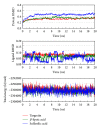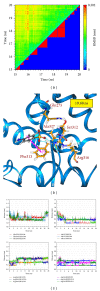Potential retinoid x receptor agonists for treating Alzheimer's disease from traditional chinese medicine
- PMID: 24876869
- PMCID: PMC4021742
- DOI: 10.1155/2014/278493
Potential retinoid x receptor agonists for treating Alzheimer's disease from traditional chinese medicine
Abstract
Alzheimer's disease is neurodegenerative disorder due to the accumulation of amyloid- β in the brain and causes dementia with ageing. Some researches indicate that the RXR agonist, Targretin, has also been used for treatment of Alzheimer's disease in mouse models. We investigate the potent candidates as RXR agonists from the vast repertoire of TCM compounds in TCM Database@Taiwan. The potential TCM compounds, β -lipoic acid and sulfanilic acid, had higher potent binding affinities than both 9-cis-retinoic acid and Targretin in docking simulation and have stable H-bonds with residues Arg316 and some equivalent hydrophobic contacts with residues Ala272, Gln275, Leu309, Phe313, Val342, Ile345, and Cys432 as Targretin. The carboxyl or sulfonyl hydroxide group can form a H-bond with key residue Arg316 in the docking pose, and the phenyl group next to the carboxyl or sulfonyl hydroxide group can form a π interaction with residue Phe313. Moreover, β -lipoic acid and sulfanilic acid have stable H-bonds with residue Gln275, Ser313, and residue Ala327, respectively, which may strengthen and stabilize TCM candidates inside the binding domain of RXR protein. Hence, we propose β -lipoic acid and sulfanilic acid as potential lead compounds for further study in drug development process with the RXR protein against Alzheimer's disease.
Figures










Similar articles
-
Discovery of small molecules from natural compound databases as potent retinoid X alpha receptor agonists to treat Alzheimer's disease.J Biomol Struct Dyn. 2024 Feb 19:1-15. doi: 10.1080/07391102.2024.2313166. Online ahead of print. J Biomol Struct Dyn. 2024. PMID: 38373033
-
Investigation of silent information regulator 1 (Sirt1) agonists from Traditional Chinese Medicine.J Biomol Struct Dyn. 2013;31(11):1207-18. doi: 10.1080/07391102.2012.726191. Epub 2012 Oct 17. J Biomol Struct Dyn. 2013. PMID: 23075283
-
In Silico Investigation of Potential PARP-1 Inhibitors from Traditional Chinese Medicine.Evid Based Complement Alternat Med. 2014;2014:917605. doi: 10.1155/2014/917605. Epub 2014 Apr 30. Evid Based Complement Alternat Med. 2014. PMID: 24876881 Free PMC article.
-
Retinoid X receptor ligands: a patent review (2007 - 2013).Expert Opin Ther Pat. 2014 Apr;24(4):443-52. doi: 10.1517/13543776.2014.880692. Epub 2014 Jan 24. Expert Opin Ther Pat. 2014. PMID: 24456080 Review.
-
A review of the molecular design and biological activities of RXR agonists.Med Res Rev. 2019 Jul;39(4):1372-1397. doi: 10.1002/med.21578. Epub 2019 Apr 3. Med Res Rev. 2019. PMID: 30941786 Free PMC article. Review.
Cited by
-
Molecular docking studies of (4Z, 12Z)-cyclopentadeca-4, 12-dienone from Grewia hirsuta with some targets related to type 2 diabetes.BMC Complement Altern Med. 2015 Mar 20;15:73. doi: 10.1186/s12906-015-0588-5. BMC Complement Altern Med. 2015. PMID: 25885803 Free PMC article.
-
Integrative approaches in Alzheimer's disease: evaluating the potential of traditional, complementary, and integrative medicine (TCIM).Front Pharmacol. 2025 Jun 30;16:1561702. doi: 10.3389/fphar.2025.1561702. eCollection 2025. Front Pharmacol. 2025. PMID: 40661073 Free PMC article. Review.
-
Computational Study of Asian Propolis Compounds as Potential Anti-Type 2 Diabetes Mellitus Agents by Using Inverse Virtual Screening with the DIA-DB Web Server, Tanimoto Similarity Analysis, and Molecular Dynamic Simulation.Molecules. 2022 Jun 21;27(13):3972. doi: 10.3390/molecules27133972. Molecules. 2022. PMID: 35807241 Free PMC article.
-
Neuroprotective Effect of Fructus broussonetiae on APP/PS1 Mice via Upregulation of AKT/β-Catenin Signaling.Chin J Integr Med. 2021 Feb;27(2):115-124. doi: 10.1007/s11655-019-3178-4. Epub 2020 Jan 4. Chin J Integr Med. 2021. PMID: 31903532
-
Alzheimer Disease: Clues from traditional and complementary medicine.J Tradit Complement Med. 2017 Jan 16;7(4):380-385. doi: 10.1016/j.jtcme.2016.12.003. eCollection 2017 Oct. J Tradit Complement Med. 2017. PMID: 29034183 Free PMC article. Review.
References
-
- Crunkhorn S. Neurodegenerative disease: RXR agonist reverses Alzheimer’s disease. Nature Reviews Drug Discovery. 2012;11(4):p. 271. - PubMed
-
- LaFerla FM. Preclinical Success against Alzheimer's Disease with an old drug. New England Journal of Medicine. 2012;367(6):570–572. - PubMed
-
- Aicardi G. New hope from an old drug: fighting Alzheimer's disease with the cancer drug bexarotene (targretin)? Rejuvenation Research. 2013;16(6):524–528. - PubMed
LinkOut - more resources
Full Text Sources
Other Literature Sources
Research Materials
Miscellaneous

